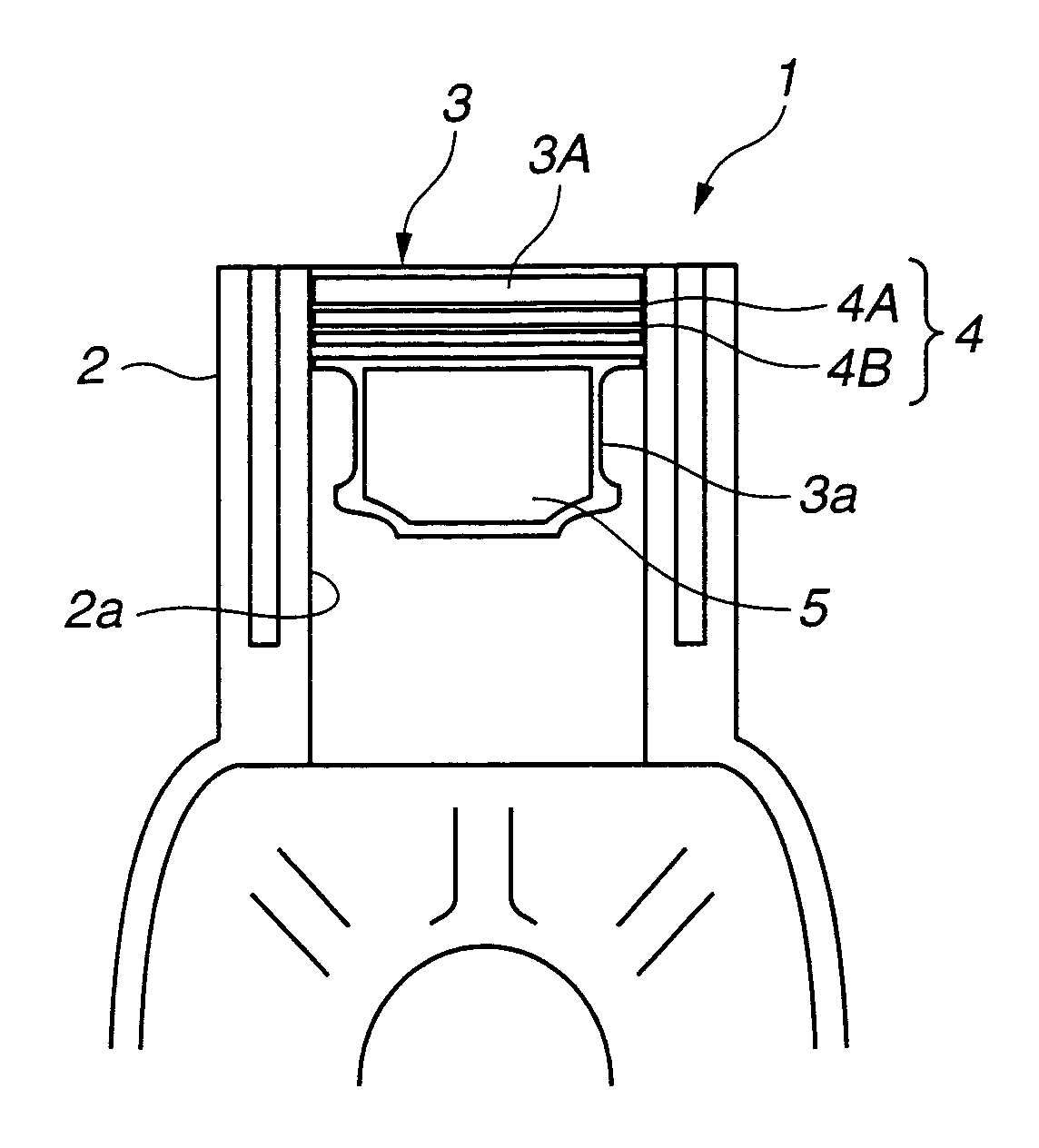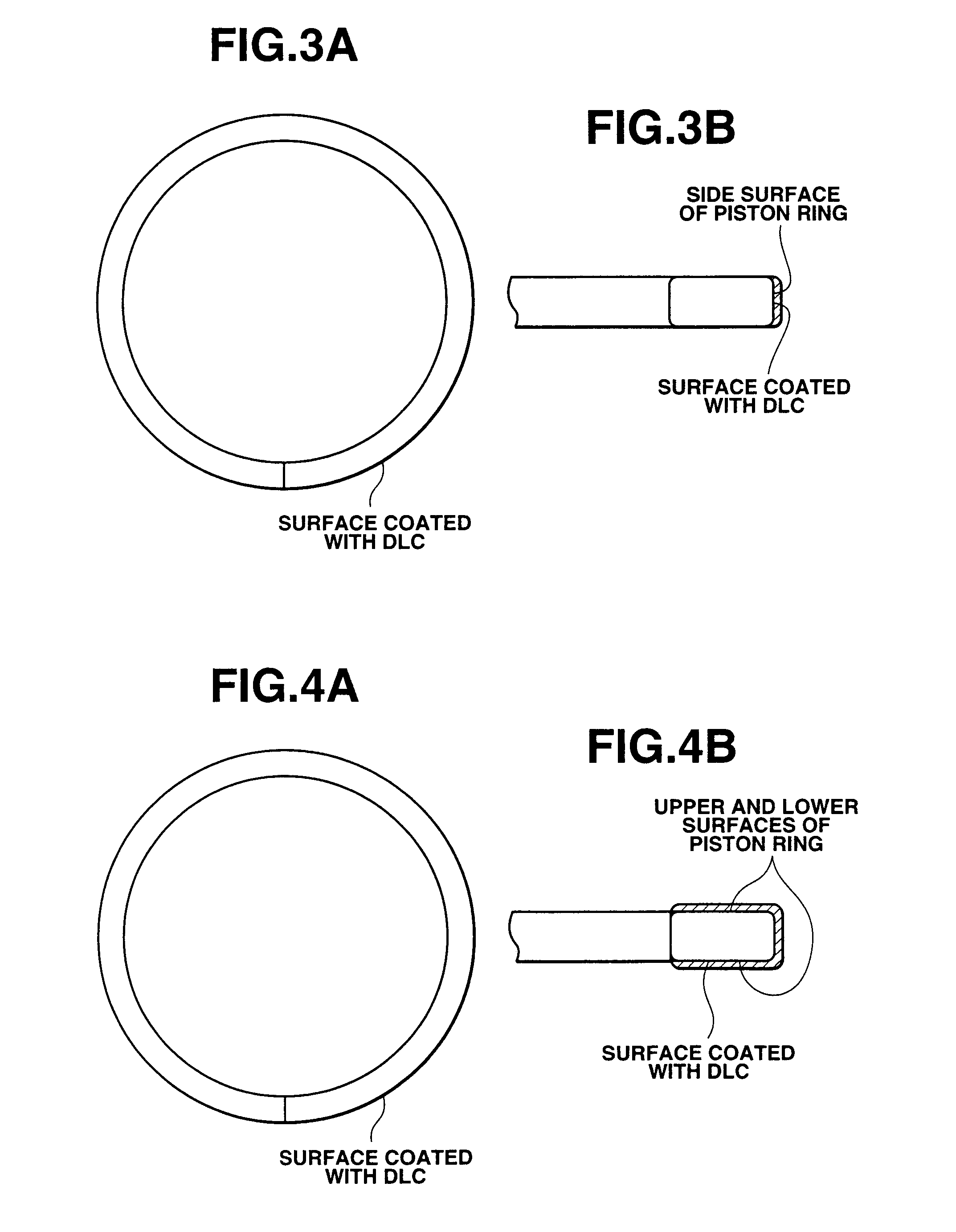Piston for internal combustion engine
a technology for internal combustion engines and pistons, which is applied in the direction of machines/engines, mechanical equipment, coatings, etc., can solve the problems that dlc materials cannot provide a sufficiently low friction coefficient, and the dlc material does not provide a low friction coefficient in the presence of lubricating oil, so as to achieve low friction coefficient, high abrasion resistance, and low friction performance
- Summary
- Abstract
- Description
- Claims
- Application Information
AI Technical Summary
Benefits of technology
Problems solved by technology
Method used
Image
Examples
first embodiment
[0026]A first embodiment of a piston for an internal combustion engine, according to the present invention will be discussed with reference to FIGS. 1 and 2.
[0027]Referring now to FIG. 1, an internal combustion engine for an automotive vehicle is illustrated by reference numeral 1. Engine 1 includes cylinder block 2 formed of eutectic or hyper-eutectic aluminum alloy. Cylinder block 2 is formed with cylinder bore section 2a. Piston 3 according to the present invention is movably disposed in cylinder bore section 2a in such a manner as to make its reciprocating motion. Piston 3 includes main body section 3A formed of a base material such as iron-based material (steel) or aluminum-based material (aluminum alloy), and formed with two piston ring grooves (not identified). Piston rings 4 (top ring 4A and oil ring 4B) are respectively fitted in the piston ring grooves of main body section 3A. Piston main body section 3A is an integral one-piece member including piston skirt section 3a. Th...
experiment 1
[0071]The present invention will be more readily understood with reference to the following Examples in comparison with Comparative Examples; however, these Examples are intended to illustrate the invention and are not to be construed to limit the scope of the invention.
example 1-1
[0072]A generally semicylindrical test piece as a base material having a dimension of 8×12×40 mm was cut out from a raw material of S45C steel (according to JIS G4051). A DLC film was formed at the semicylindrical surface of this test piece by an arc ion plating process (PVD), thereby producing a specimen corresponding to a sliding part of a piston in an automotive internal combustion engine. The DLC thin film had a hydrogen atom content of not more than 0.5 atomic %, a Knoop hardness Hk of 2170 kg / mm2, a maximum height Ry of 0.03 μm, and a thickness h of 0.5 μm. The maximum height Ry was explained as Rz in JIS (Japanese Industrial Standard) B 0601 (:2001). Then, the specimen underwent a frictional wear test in which a material FC250 (according to JIS G5501) was used as an opposite specimen corresponding to the cylinder bore section (or the opposite member), the test being carried out in a lubricating oil containing no additive.
PUM
| Property | Measurement | Unit |
|---|---|---|
| Ra | aaaaa | aaaaa |
| Ra | aaaaa | aaaaa |
| depth | aaaaa | aaaaa |
Abstract
Description
Claims
Application Information
 Login to View More
Login to View More - R&D
- Intellectual Property
- Life Sciences
- Materials
- Tech Scout
- Unparalleled Data Quality
- Higher Quality Content
- 60% Fewer Hallucinations
Browse by: Latest US Patents, China's latest patents, Technical Efficacy Thesaurus, Application Domain, Technology Topic, Popular Technical Reports.
© 2025 PatSnap. All rights reserved.Legal|Privacy policy|Modern Slavery Act Transparency Statement|Sitemap|About US| Contact US: help@patsnap.com



